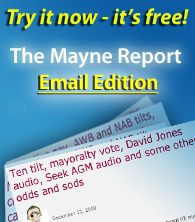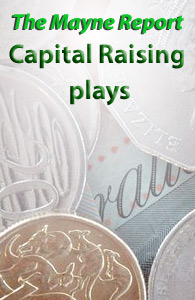Shares
Chronological list of 460+ >$20m+ post Covid-19 capital raisings
Here is a reverse chronological list (based on retail offer closing date) of more than 450 capital raisings above $20m announced after the Covid-19 crisis hit in March 2020. We've italicised those which, with the benefit of hindsight, should have been avoided. The biggest year initially was 2020 with 120, followed by 86 in 2022, 60 in 2021 and 60 in 2023. Then we had a blockbuster 133 deals in 2024 and 6 so far in January 2025.
Mar. 22, 2025
February 28 2025 last day losses above $5m
This list tracks last day losses above $5m on the final day of the reporting and the time that they dropped.
Mar. 4, 2025
Mesoblast capital raising history
A history of Mesoblast capital raisings, tracking selective placements to professional investors with no chance for retail shareholders to participate. Turns out they've done 11 placements that weren't accompanied by an SPP and just one pro rata issue in 2017.
Jan. 28, 2025
S&P index change announcements
This work in progress list provides links to S&P index change announcements applying to ASX listed companies over the past 20 years.
Mar. 10, 2025
Shame file: stand alone placements with no SPP
The following list tracks more than 100 examples of companies which shamefully did stand alone institutional placements over the past 25 years that weren't accompanied by a Share Purchase Plan for retail investors, therefore diluting them without compensation and delivering easy fees to their investment bankers. If we've missed any, please email the details to stephen@maynereport.com.
Mar. 20, 2025
Trading history in more than 1200 stocks
Here is a complete alphabetical list of Stephen Mayne's share dealings in almost 900 companies over the years. Go here for the full portfolio and trading histories sliced and diced in a variety of interesting ways. Codes to be chased down on Commsec due to a change: AEL, AOV, ATH, AXN, AZJ, BEN, BRG, BTM, COL, CQR, CVW, DNA, ECS, EPN, EVT, FBR, GLL, GWA, HLO, HLS, HUM, INA, IPL, MBH, MCM, MOZ, MSB, MYS, NGI, NOU, NRZ, OBL, PAC, PGC, PIA, PNV, PRN, PXA, QUB, RHC, RPL, S32, SCG, SEG, SFG, SLS, SNT, SPK, SQ2, SRG, SVR, SWM, TLC, TPG, TUA, TWE, VAU, VCX, WGB, WJL, WLE, WMA, YAL.
Mar. 19, 2025
History of ASX mass delistings over listing fees
The ASX requires companies to pay their full financial year listing fee by late August each year and names those who haven't paid, with the threat of delisting within a week. Here is a list looking back at major culls over the years.
Feb. 8, 2025
Former listed companies where investors lost $100m+
Below is a list of almost 100 (87) former ASX listed companies where investors lost more than $100m overall. We're expecting this list will eventually top 200. Also, see this companion list looking at current listed companies with accumulated losses exceeding $100 million which haven't recovered that loss through a strong share price. Corrections and additions by email to stephen@maynereport.com or via Twitter to @maynereport.
Jan. 14, 2025
Existing listed companies carrying accumulated losses exceeding $100m
This list tracks almost 100 listed companies which have notched up accumulated losses exceeding $100 million and have not yet recovered that value through its share price. Also, see this companion list looking at former listed companies which cost shareholders more than $100 million. Corrections and additions by email to stephen@maynereport.com or via Twitter to @maynereport.
Feb. 28, 2025
Summary of ASX monthly data releases
The ASX releases monthly statistics of market activity and after 21 consecutive monthly reductions in the number of listed entities, we finally managed a positive month in November 2024, before the declines resumed in December and January. After reaching 2,294 on January 31, 2023, the numbers dropped by 193 or 8.41% to 2,101 on February 28, 2025. August is always the biggest monthly reduction (see 10 years of data below) and the loss of a net 28 listings in August 2024 was the biggest monthly net reduction in a decade.
Mar. 18, 2025
Companies which did a triple raising with a placement, entitlement offer and SPP
This list tracks companies which did a triple raising with a placement, entitlement offer and SPP, the latter often coming up after retail shareholder anger about being diluted.
Jan. 29, 2024
Non-renounceable offers where overs were completely banned
This list tracks 27 bad boy issuers which did non-renounceable entitlement offer raisings for more than $20m where retail investors were banned from applying for additional shares, leaving the shortfall exclusively for under-writers.
Jul. 1, 2024
Examples of non-renounceable deals with unlimited overs
This list provides almost 50 examples of capital raisings which offered retail shareholders unlimited overs in a non-renounceable capital raising. There have been dozens of examples over the years but in recent years the trend has been to pre-cap "overs" based on a percentage of entitlement, such as 50%. See this list for examples of that unfair practice which increases the chances of a retail shortfall going to big end of town under-writers.
Jul. 1, 2024
190 examples of last day laggard accumulated losses above $20m
190 examples of last day laggard companies which reported on Friday, August 30 (or later) and finished the disclosure with accumulated losses exceeding $20m. Those which are italiced are in front for investors based on the current market cap.
Oct. 8, 2024
Useful lists tracking all elements of Australian capital raisings
Useful lists tracking all elements of Australian capital raisings.
Apr. 9, 2023
Floats where investors lost more than $200 million
This list tracks floats since 1988 where investors collectively lost more than $200 million overall. We've got 37 so far but there will be many more. Send any suggestions through to stephen@maynereport.com.
Feb. 28, 2025
Entitlement offers with overs where everyone given a minimum allocation
This list provides examples of entitlement offers with unlimited overs which were subsequently scaled back where all applicants were given a minimum allocation before pro-rata based on size of holding kicked in.
Jul. 1, 2024
Placements with entitlement offers where no SPP offered
The following list tracks companies which did institutional placements over the past few years that diluted retail investors who are now owed a share purchase plan to make good the injustice.
Jan. 11, 2024
AREO capital raisings which compensated non-participants but had no retail rights trading
This list tracks AREO capital raisings which compensated or attempted to compensate non-participants but offered no rights trading, a rarely used structure which was the precursor to the PAITREO.
Jul. 1, 2024
Excessively large placements twinned with entitlement offers
The following list provides examples of companies which twinned a selective placement with a pro-rata entitlement offer where the placement was more than 20% of the total. We prefer pro-rata and hate selective placements so this should be seen as a shame file of bad practice, although not as bad as this list of standalone placements where there wasn't even an SPP offered.
Jul. 1, 2024
Best practice capital raising outcome announcements
Here is a list of best practice announcements by companies at the end of capital raisings in terms of disclosing information about retail shareholder participation rates.
Jul. 1, 2024
Companies which pre-limited "overs" on pro-rata raisings
This list tracks the small number of companies which limited the amount of additional shares or "overs" that retail shareholders could apply for in a non-renounceable issue, before seeing how big the shortfall actually was.
Jul. 4, 2024
Companies which uncapped SPPs after strong demand
This list tracks more than 50 examples of capital raisings which started with an announced cap on the overall size of an SPP and then saw it completely lifted to ensure there was no scale back. Also, check out this list of companies which stuck rigidly to their SPP cap, plus this list of those which partially lifted the cap but still imposed a scale back.
Dec. 18, 2024
Companies which lifted capped SPPs but still rejected applications
This list tracks almost 50 SPPs where the issuer mentioned a cap in the offer document but then expanded it after strong demand but still imposed a scale back. Also, check out this list of companies which stuck rigidly to their SPP cap, plus this list of those which completely uncapped an SPP to ensure there was no scale back.
Dec. 20, 2024
SPP scale-backs where everyone given minimum allocation
This list tracks companies which scaled back retail applications in SPPs using a formula which included a minimum allocation to all applicants and pro rata after that.
Jul. 4, 2024
36 SPPs priced on VWAP at a discount to earlier placement
This list looks at Share Purchase Plans (SPPs) which offered a VWAP pricing alternative that delivered a final price lower than what institutions paid in the earlier placement.
Aug. 5, 2024
Largest SPP scale backs by dollar size
This list tracks the biggest SPP scale backs above $5 million ranked by dollars size with a further list of undisclosed dollar scale backs below that.
Oct. 6, 2024
Companies which launched an SPP without a cap
This list tracks companies which launched an uncapped SPP without identifying how much it wished to raise.
Jul. 4, 2023
Where the SPP matched or was larger than the placement
This list tracks companies which launched a stand alone SPP (excluding LICs) or where the SPP ended up matching or raising more funds than the earlier placement.
Jul. 20, 2022
Companies which scaled back SPPs based on size of application
Here is a list of some of the companies which have scaled back SPPs based on the size of a shareholder's application.
Dec. 22, 2024
Companies which refused to expand capped SPPs
This list tracks companies which refused to lift capped SPPs. Also, check out this list of companies which partially lifted caps but still imposed a scale back, along with this list of those which accepted all applications and imposed no cap.
Dec. 20, 2024
SPPs above $100m in the Australian market
This list tracks the biggest share purchase plans for retail investors conducted by ASX listed companies above $100 million.
Jan. 11, 2024
Bellevue Gold capital raising letter
This email was sent on Saturday, 14 Jan 2023 just after Bellevue Gold's $10m SPP closed.
Jan. 10, 2024
Biggest institutional placements above $500m in Australian market
This list tracks the biggest institutional placements above $500m by ASX listed companies.
Jan. 14, 2024
History of Macquarie capital raisings and principle investments
This list looks at the history of Macquarie Group capital raisings since it floated in 1996, along with the major transactions it has pursued both through its funds management operations and using its own balance sheet.
Jun. 30, 2023
Tracking off-market buybacks in Australia
This list tracks the outcomes of off-market buybacks in the Australian market, which are in the process of being banned by the Albanese Government as part of a crackdown on franking credits.
Mar. 14, 2023
Tracking retail take-up rates in pro-rata offers
The following lists tracks retail take up rates in pro-rata capital raising offers.
Jan. 11, 2024
Tracking the outcomes of PAITREOs
This list tracks what has happened when companies raised capital by way of a PAITREO. It's a renounceable structure and the most important point is whether non-participating institutional or retail shareholders receive the bigger compensation payment from separate bookbuilds. At the moment retail have 16 wins, instos 21 and there have been 5 draws. Here is the detail.
Dec. 27, 2023
Macquarie capital raisings that mistreated retail shareholders
Here is a partial list of capital raisings which Macquarie Group has been involved with that diluted or mistreated retail shareholders.
Dec. 24, 2024
Companies which scaled back retail applications based exclusively on size of holding
This list tracks companies which scaled back retail shareholders in entitlement and SPP offers based solely on size of holding, therefore giving small investors a minimal allocation.
Jan. 11, 2024
Update announcements during retail capital raisings
Companies providing an update on applications before a retail capital raising offer has closed has been a new phenomenon in 2020. Here is list of those who've done it after a request from this website.
Oct. 13, 2024
Campaigning for better retail treatment in capital raisings
Here are links to various activities over the years advocating for better treatment of retail investors in capital raisings.
Apr. 24, 2020
The SPP shame file since 2007
Companies since the beginning of 2007 which did cosy placements with big institutions but then treated shareholders differently.
Apr. 14, 2022
How two-tiered capital raising hurt retail investors
This list tracks the contrasting experience of investors when a renounceble entitlement offer has two separate bookbuilds to deal with the shortfall.
Feb. 27, 2014
Cancelled and postponed dividend payments during COVID
A chronology of the listed company announcements which either cancelled or post-poned dividends were declared in February 2020 as the pandemic first hit.
not published
Companies which left the door open in capital raisings
The following list tracks companies which announce capital raisings but then leave the door open for new shareholders to buy in by having a later record date. The issue was explored in the October 5 email edition.
Dec. 31, 2018
Companies which allowed major holder or director to lift stake in capital raising
This list tracks capital raisings which have allowed major shareholders or directors to increase their percentage stake.
Dec. 15, 2014
Takeovers we've been forced to accept since 2005
Here is an incomplete list of takeover bids we've accepted or been forced to accept since we started building the world's biggest small share portfolio in 2005. Go here for the full portfolio and trading histories sliced and diced in a variety of interesting ways. We'll add the recent takeover details some time soonish. Maybe.
Feb. 8, 2025
Shares retained in collapsed companies
Here is a list of public companies that I've had the unfortunate experience of being on the share register when they've collapsed or gone into administration.
Jan. 6, 2014
Letter sent to Metcash IR chief Steve Ashe re SPP
Below is the text of an email sent to Metcash Investor Relations chief Steve Ashe late on February 28, 2024 lobbying for an expansion of its $25 million share purchase plan, which closed on March 1. The announcement delivered an increase to $60 million after $153 million in applications were received and a minimum allocation of $1000. All up, not a bad outcome.
Mar. 18, 2024
Letter sent to Orica re 2024 SPP
Below is the text of an email sent to Orica's PR and investor relations managers late on Sunday, March 17, 2024, lobbying for an expansion of its $65 million share purchase plan, which closed on March 18. Sadly, the outcome announcement stuck rigidly to the $65m cap, even after $100 million in applications were received. There was a minimum allocation of $1000 worth of shares for all 5,700 applicants and a pro rata allocation based on size of holding after that.
Mar. 26, 2024
Directors who have sold shares to avoid margin calls or pay out margin loans
Here is a list of publicly known and suspected margin calls suffered by directors of public companies and public companies themselves during the great credit crunch of 2007-08.
Feb. 8, 2025
Copyright © 2025 The Mayne Report. All rights reserved




















